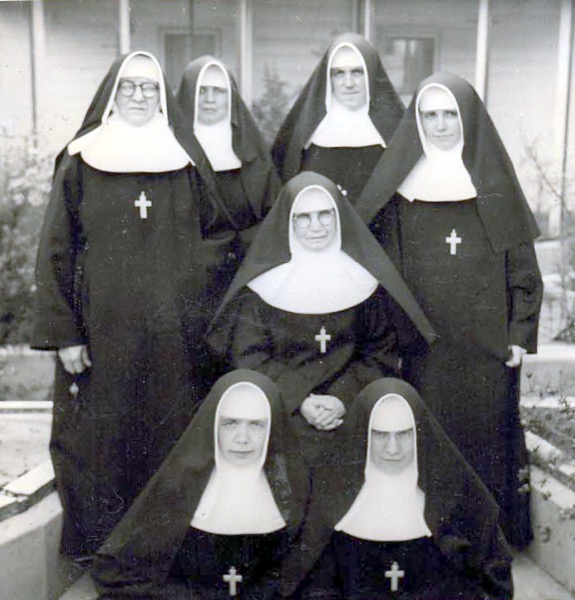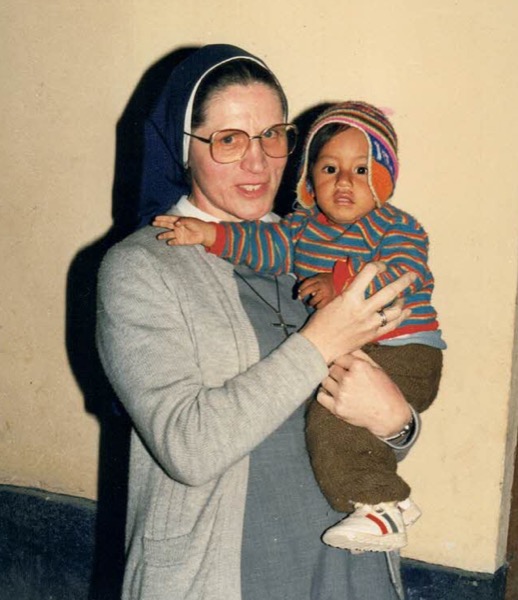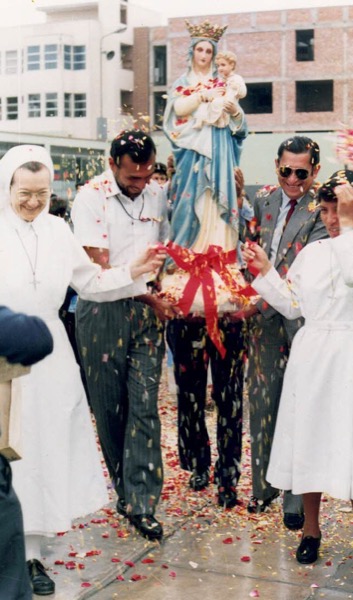The Presence of MSC Sisters in the Peruvian Province

In the first half of the 19th century, word had gotten out that the MSC congregation was spreading to other continents and countries and so the President of the Republic of Peru contacted the Congregation in Hiltrup, Germany requesting the sending of sisters for various social works. When the large community at the motherhouse heard about this proposal, there were expressions of joy and in many hearts the missionary fire was lit with new ardor. The generosity of dedication and unconditional availability to be sent had not diminished in the congregation, even though the sisters were aware that the radical demands had not changed much.
Thanks to this missionary zeal, the first 6 sisters arrived in Lima, Peru’s capital, on June 20, 1938. The services requested by state institutions opened several fields of missionary activity. The first to benefit were the poorest children from the neighborhoods of Lima who were given a short stay in the Vacation Colony near Ancon beach about 40 km from Lima. The sisters were going to oversee the running of this institution with all that it entails. Not having their own house in the capital, the sisters moved immediately to this place and a few days later receive 100 “unruly” boys who arrived on a train through the desert that stopped at the door of the house. Not knowing the language and conditions of the colony, the sisters were overwhelmed. Some local people came to their aid, but the sisters found themselves unable for a time to properly attend to the needs of the children, much less to transmit to them the message of the Good News.
In addition, they suffered hostility from some people who did not view their presence favorably. All these experiences, however, could not overcome the enthusiasm and efforts of the sisters. Soon they were given all the powers to improve the conditions of the House and above all to begin their catechetical work. They were supported by some very kind and generous ladies.

The sisters provided the groups of children that changed each month with Christian formation and a comprehensive school education. These children welcomed the message of God’s love with great joy and prepared for the sacraments and other experiences of faith. An anecdote shows how religious things were familiar to them: Every day they went to the beach for a few hours where they found many shells of different sizes. With these, rosaries were made. The larger shells were the “Our Fathers” and the smaller were the “Hail Mary’s”. One day a boy stuck a large shell up his nose and there was no way to get it out. At the medical post the doctor asked him, “What’s wrong with you boy?” to which he replied very seriously, “I think I have an Our Father in my nose.”
Although the time of stay was short, most of the children have never forgotten this experience of being welcomed, loved, valued, cared for, and corrected. They have since been the messengers of this experience among their families and friends.
Another large group of society that lived at a great disadvantage were the simple workers who especially lacked adequate health care. The government was building a huge hospital for them in Lima but did not have the personnel to care for the various services. The government made a contract with Mother Electa, Superior General at that time, to send 105 MSC Sisters including nurses and others who would assume responsibility in the different areas of the institution. In addition, they were asked to open a nursing school for young people, since there was no such facility in the country. The expectation and availability of the sisters ignited the missionary fire and soon several groups of sisters were assigned for this service.
At their new mission they had to confront great challenges and many obstacles. In the hospital, the nursing sisters had to assume responsibility for the care of 100 patients per floor. It was doubly delicate since they did not master the language of medicine and did not understand the respective instructions. From the beginning, they worked very closely with the lay staff of the institution, who showed much understanding and kindness and welcomed language mistakes with respect and laughter, such as confusing ‘esposa’(wife) with ‘escoba’(broom) or ‘condolencias’(condolences) with ‘felicidades’ (congratulations).
The sisters considered their main commitment to make the effort to experientially announce the love of God as expressed in the MSC charism. An element that greatly favored this task was the deep religiosity of the Peruvian people who were largely baptized Catholics and welcomed Devotions to the Sacred Heart and the Virgin Mary with great enthusiasm.
The sisters, in their daily contact with the sick and other workers of the institution, expressed their respect, kindness, understanding, goodness and tenderness with everyone without distinction, and little by little, they shared with them the experience of the human love of the Sacred Heart. Many sick people remained in the hospital for a long time and were thus instructed in the authentic doctrine of the Church, prepared for the sacraments, and even formed a choir of the sick to accompany the liturgical celebrations. This tireless effort was extended to the families of the patients and the poor in the neighborhood whom the sisters visited to attend to their basic needs and to include them in the manifestation of faith and devotions.

Other bearers of the MSC charism and respective devotions were the nurses who graduated from the School of Nursing directed by the sisters. These graduates went to work in many places in the country where they were highly appreciated for their efficient work and their kind dedication to the patients and all the people with whom they interacted. The congregation later assumed the service of small hospitals for workers in other cities of the country, where they witnessed spirituality with the same enthusiasm and generous dedication characteristic of an MSC. In this sense, the MSC value and highlight the contribution of the sisters in domestic work and other “silent” and sacrificial services. Only God knows the love and sincere dedication of each sister.
In the following years the Congregation expanded, and the sisters took on the challenge of sharing the charism and mission in several parishes led by the Missionaries of the Sacred Heart, both in the capital and in remote towns. The main commitments of the sisters consisted of the comprehensive education of children through parish schools, catechesis at all levels, free care for the sick in small health centers, visits to the poor in neighborhoods, teaching sewing workshops for women, and other means to offer basic aid to families, thus improving conditions of extreme poverty and building together with the missionaries and lay collaborators the Christian community.
The simple people showed great acceptance of the devotion to the Sacred Heart and Our Lady of the Sacred Heart. In the MSC parish in Lima, they built a sanctuary in honor of Our Lady of the Sacred Heart to which many devotees came – and continue to come to this day. Another testimony to the vitality of their spirituality were the social service activities in which many lay men and women generously participated.
After Vatican II there was a new way of looking at the poor. This new vision consisted mainly of going to meet the poor, respecting, valuing them and supporting them in assuming their role in development. Many of our sisters became aware of this challenge and, as in other congregations, felt driven to a new form of evangelization called “insertion”. This option sprang from an authentic spirituality of the Heart. A group of sisters, German and especially Peruvian, who had already joined the Congregation, decided to “go out” to the peripheries, live like the poor, to share their lives and their efforts to take center stage in their development. MSC Sisters opened several communities in very poor areas, new urbanizations, and isolated places in the Sierra Mountains and Selva Rain Forest. These testimonies became authentic forms of the announcement of God’s love. It became more evident in dramatic situations of threats from terrorism from the “Shining Path” when the sisters freely decided to remain among the threatened and persecuted people.
The situation in the world and in Peru continues to change rapidly. It takes many sincere and courageous efforts to “incarnate” the MSC charism and our missionary testimony with bold choices which must be rooted in a deep relationship with the Heart of Christ.
It is difficult to give warmth if we ourselves are cold;
a stove without a fire does not heat a room.
If a heart is filled with love for Christ,
it will automatically share this heart with others,
just as a burning stove radiates its hidden warmth.
The love in our own heart is a fire
which will turn into an all-consuming conflagration,
like a flare which wants to start fires everywhere.”
(Fr. Linckens, Retreat, 3rd Talk)
FOR PERSONAL REFLECTION
When you get in touch (emotionally, spiritually) with this story, what are the essential qualities of our charism/spirituality that you see incarnated in the life and mission of those sisters?
